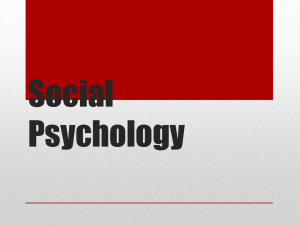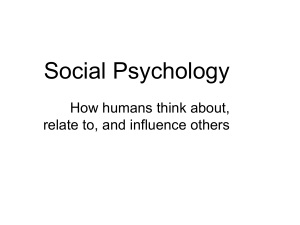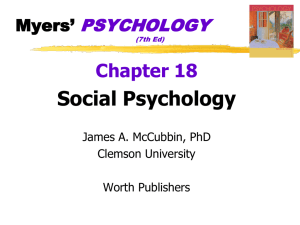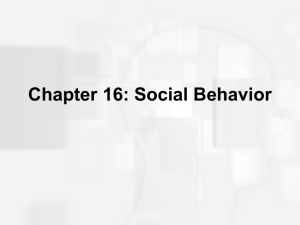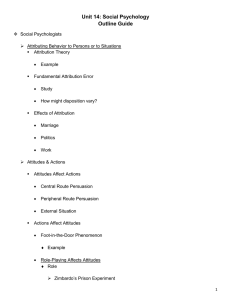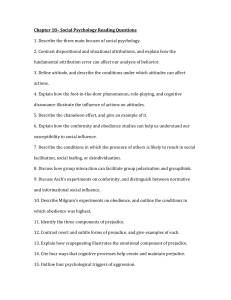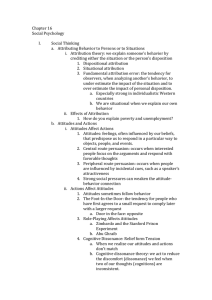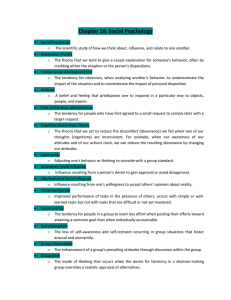Social Psychology
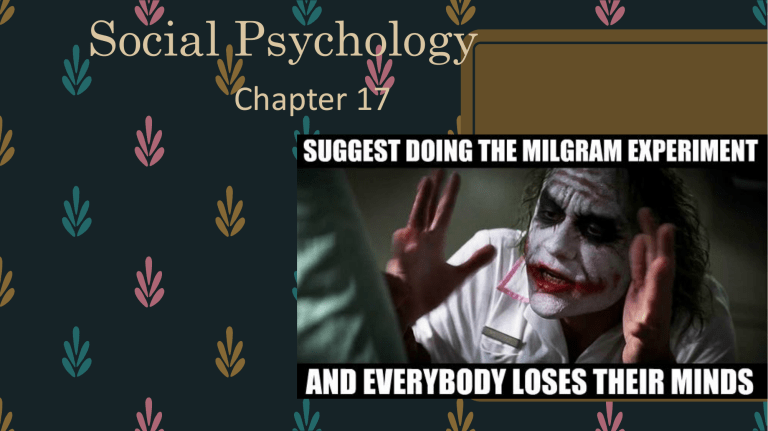
Social Psychology
Chapter 17
Social Psych Experiment
3 mins
– https://www.youtube.com/watch?v=a71h6LZKXTcv
Social Psychology
– The scientific study of how we think about, influence, and relate to one another.
– Social thinking involves thinking about others, especially when they engage in doing things that are unexpected.
– Does a person’s absenteeism signify illness, laziness, or stressful work atmosphere?
– Was the horror of 9/11 the work of crazed evil people or ordinary people corrupted by life events?
Persuasion
– Meaning influence
– The purpose is to change a groups attitude
– Richard Petty and John Cacioppo
– Two methods in which individuals can be persuaded.
– Central route to persuasion
– Peripheral route to persuasion.
Target- Black Friday!
– https://www.youtube.com/watch?v=CF-mUn54OGA
Attributing Behavior to Persons or to Situations
– Attribution Theory – Fritz
Heider suggested that we have a tendency to give causal explanations for someone’s behavior, often by crediting either the situation or the person’s disposition.
Attributing Behavior to People or to
Situations
– Dispositions are enduring personality traits.
– So, if someone is quiet, shy, and introverted, they are likely to be like that in a number of situations.
– A teacher may wonder whether a child’s hostility reflects an aggressive personality (dispositional attribution) or is a reaction to stress or abuse
(situational attribution
Fundamental Attribution Error
– The tendency to overestimate the impact of personal disposition and underestimate the impact of the situations in analyzing the behaviors of others.
– We may see Joe as quiet, shy, and introverted most of the time, but with friends he is very talkative, loud, and extroverted.
Effects of Attribution
– How we explain someone’s behavior affects how we react to it.
Attribution of Responsibilities
Activity
– Please flip to the back page of you lecture notes, there should be a blank space to write in
Attitudes & Actions
– A belief and feeling that predisposes a person to respond in a particular way to objects, other people, and events.
– If we believe a person is mean, we may feel dislike for the person and act in an unfriendly manner.
– Our attitudes predict our behaviors imperfectly because other factors, including the external situation, also influence behavior.
Actions & Attitudes
– Foot-in-the-Door Phenomenon – the tendency for people who have first agreed to a small request to comply later with a larger request.
– Role Playing Effect – when people are assigned to roles, they tend to adopt role appropriate attitudes.
– Cognitive Dissonance – when our attitudes and our actions are opposed.
– Self-serving bias- is people's tendency to attribute positive events to their own character but attribute negative events to external factors.
The Halo Effect
– Created By Edward Thorndike
– Halo effect is a cognitive bias in which an observer's overall impression of a person, company, brand, or product influences the observer's feelings and thoughts about that entity's character or properties.
Social Influence
– The greatest contribution of social psychology is its study of attitudes, beliefs, decisions and actions and they way they are molded by social influence.
Conformity & Obedience
Conformity
– Behavior is contagious, modeled by one followed by another. We follow behavior of others to conform.
– Other behaviors may be an expression of compliance (obedience) toward authority.
Obedience
Solomon Asch and conformity
– 1950s experiment
– Asch wanted to test conformity and how it was effected by gender, age, culture, task importance
– Experiment: A participant was brought into the room with a group of actors.
Everyone was asked which line is longer.
Everyone would state the wrong answer to see if the one participate would agree and say the wrong answer.
Group Pressure & Conformity
– Suggestibility is a subtle type of conformity, adjusting our behavior or thinking toward some group standard.
An influence resulting form one’s willingness to accept other’s opinions about reality.
Conditions that Strengthen Conformity
– One is made to feel incompetent or insecure.
– The group has at least three people.
– The group is unanimous.
– One admires the group’s status.
– One has no prior commitment to a response.
– The group observes one’s behavior.
– One’s culture strongly encourages respect for a social standard.
Obedience
– Obedience
– compliance of person is due to perceived authority of asker
– request is perceived as a command
– Milgram interested in unquestioning obedience to orders
Stanley Milgram
Obedience
– People comply to social pressures. How would they respond to outright command?
– Stanley Milgram designed a study that investigates the effects of authority on obedience.
– Participants were pressured to choose between following their standards and being responsive to others.
Stanley Milgram’s Studies
– Teacher goes to another room with experimenter
– Shock generator panel – 15 to 450 volts, labels “slight shock” to “XXX”
– Asked to give higher shocks for every mistake learner makes a mistake
Follow-Up Studies to Milgram
Social Influence
Some individuals resist social coercion
Social Facilitation
Social Relations
§ In group
“Us”- people with whom one shares a common identity
Ingroup Bias – the tendency to favor one’s own group.
§ Outgroup
“Them”- those perceived as different or apart from one’s ingroup
How do groups affect our behavior?
• One person affecting another
• Families
• Teams
• Committees or Task Groups
Individual Behavior in the Presence of
Others
– Social Facilitation – refers to improved performance on tasks in the presence of others.
– Triplett (1898) noticed cyclists’ race times were faster when they competed against others than when they just raced against the clock.
– Deindividuation – the loss of self-awareness and self-restraint in group situations that foster arousal and anonymity.
Effects of Group Interaction
– Group Polarization – enhances a group’s prevailing attitudes through a discussion. If a group is like-minded, discussion strengthens its prevailing opinions and attitudes.
Groupthink
– A mode of thinking that occurs when the desire for harmony in a decision-making group overrides the realistic appraisal of alternatives.
– Attack on Pearl Harbor
– Watergate Cover-Up
– Chernobyl Reactor Accident
– Luke Skywalker conspiracy
Social Relations
§ Does perception change with race?
Prejudice
– Simply called “prejudgment,” a prejudice is an unjustifiable
(usually negative) attitude toward a group and its members.
– Can lead to discrimination
– Components of Prejudice
– Beliefs (stereotypes)
– Emotions (hostility, envy, fear)
– Predispositions to act (to discriminate)
How Prejudice are People?
– Over the duration of time many prejudices against interracial marriage, gender, homosexuality, and minorities have decreased.
Cognitive Roots of Prejudice
– In vivid cases such as the 9/11 attacks, terrorists can feed stereotypes or prejudices.
Cognitive Roots of Prejudice
– The Just-World Phenomenon – the tendency of people to believe the world is just, and people get what they deserve.
Stereotypes and Schemas
Stereotypes- A widely held but fixed and oversimplified image or idea of a particular type of person or thing.
Schemas- how we organize information in order to interpret the world and build relationships cognitively
Race is not real… article
Aggressive Behavior
Bystander Intervention
– The decision-making process for bystander intervention.
Bystander Effect
– Tendency of any given bystander to be less likely to give aid if other bystanders are present .
The case of Kitty Genovese: the bystander effect
